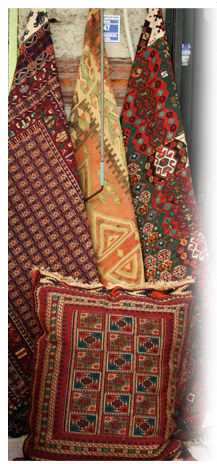 |
 |
| |
| |
 |
My aim is always to please the customer, so it is always a pleasure
to answer your questions and share information about carpets,
kilims, and sumacs, with you :
CARPETS: They are a combination
of wool, cotton or silk. A carpet can be wool on cotton, wool
on wool, silk on silk, etc. This means, for instance, that the
pile is wool and the base is cotton or the pile is wool and
the base is wool, etc. Carpets have a pile either of double
or single knots. The durability of single and double knotted
carpets is the same. Turkish carpets use a double knot system
which means the weavers put 2 knots around the wharp and weft
and then tighten them. After finishing the entire carpet, then
they use a special pair of scissors to cut and trim the pile
of the rug. In general, the designs in carpets are meant to
tell a story, and symbols have different meanings. For instance,
a scorpion symbolizes pride and liberty and an eye keeps evil
away. Thus, each one creates a different feeling and impression.
KILIMS: They are also handmade,
but they do not have knots. Instead, they are flat woven and
made with a long needle that weaves between the threads on the
loom.
Kilims also come from many different countries and have distinguished
designs and colors. Like carpets, they are symbolically designed
and their patterns tell stories. For instance, grain represents
abundance and the Cypress represent eternity. It is a matter
of taste for a customer to chose either a kilim or a carpet.
Kilims are not heavy; therefore, they can be easily moved around
a home. They are especially popular as wall decorations.
SUMACS: They are also handmade
and woven with a different technique. A sumac is woven like
a kilim then embroidered on top of the weaving. Like kilims
and carpets, their designs give them special meaning. |
|
| |
|
 |